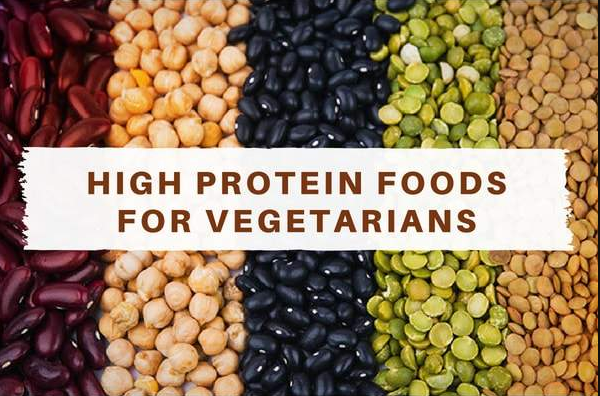Your body is never at rest – even when you sleep. Cells are constantly being broken down and then rebuilt and regenerated. In fact, this time next year, virtually every cell in your body will have died and been replaced; you’ll be a whole new skinny bitch by then. And the key material required for all of this building? Protein.
Protein Keeps You Skinny in 3 Ways:

1. Protein has higher satiation than carbohydrates, meaning you feel fuller
2. Protein has a lower impact on blood glucose
3. Protein elevates your metabolic rate – the number of calories your body uses at rest.
Protein is one of three macronutrient groups – the other two being carbohydrates and dietary fats. Where carbs and fats are generally required for energy, protein is important for other reasons. The term macro means big, which simply means humans need abundant supplies of all three of these nutrients to function properly. While there is no denying that carbs and fats are important, they are pretty easy to come by. Protein, however, is often less abundant and many people fail to get enough of this essential nutrient. We always prefer you get your nourishment from real food, but if you fear you’re not getting enough protein, you have a lot of vegan protein powders to choose from.
Build Your Body

Protein is made up of amino acids which are essentially letters of the protein alphabet. There are 20 amino acids in the protein alphabet which can be arranged in an almost infinite number of ways to make all of the cells, tissues, organs, and systems in your body. Your hair and nails, skin and bones, muscles and even your hormones all contain at least some if not many amino acids, which is why protein is such an important nutrient.
Whenever you eat protein, it’s broken down into its constituent amino acids and then put back together to make whatever it is your body needs to construct. It’s an odd concept but, for example, when you eat a high protein food like soy, your body breaks it down into its constituent parts and then turns it into things like muscle cells, toenails, or eyelashes. It’s the ultimate in recycling!
However, if you look at the Standard American Diet and most other “food pyramid” type eating plans, you’ll quickly notice that they are built around carbohydrates – usually 60% or more. While there is nothing inherently wrong with carbs (except for the fact that simple carbs will fatten you up almost overnight), they’re essential for energy. Complex carbs found in vegetables will give you loads of nutrition, provide your main source of fiber, and help you feel full after a meal. With so much emphasis on carbs, sometimes protein gets overlooked.
Neglect Your Body

Too little protein can have an adverse effect on how you look, feel, and function. If you are an ardent exerciser, too little protein can hurt the results of your workouts. Exercise speeds the breaking down of old cells as well as the regeneration of new cells. Regular exercisers need more protein than sedentary people because their cells are renewed and repaired more often. This is the very essence of getting fitter and stronger – exercise breaks your body down. Protein, combined with rest and sleep, builds you back up. Way better than any cosmetic cream or serum ever can.
Without protein, however, you have the breakdown of old cells without the ability to renew them. A lack of protein is like a lack of raw materials when you’re building a house – progress will be slow or even non-existent without the needed supplies.
The amount of protein you need on a daily basis varies according to your weight and activity levels Opinions vary as to exactly how much you need but the following chart represents the general consensus of opinion…
| Daily protein requirements in grams per kilogram of body weight | |
| Sedentary adult | 0.8 |
| Recreational adult exerciser | 0.8 – 1.5 |
| Adult endurance athlete | 1.2 – 1.6 |
| Growing teenage athlete | 1.5 – 2.0 |
| Adults building muscle mass | 1.5 – 1.7 |
| Adult estimated upper limit | 2.0 |
Protein can be found in a host of foods, the most common being those derived from animals such as milk, eggs, meat, poultry, and fish. All of these foods contain a lot of protein.
Does this mean that, if you eschew animal products, you are doomed to a life of low protein? Absolutely not! There are lots of alternative protein sources that will allow you to get all the amino acids you need to be fit, healthy, and strong without animal products.
Green peas
Low in calories, virtually fat-free, high in vitamin C, and rich in both fiber and potassium, green peas provide 5 grams of protein per 100-gram serving. Peas are such a good source of protein that it is possible to buy pea protein powder! Add a handful of peas to soups and stews to increase the protein content for just a few cents. Peas can be purchased fresh, frozen, dried, and tinned, and fresh peas can be consumed cooked or raw.
Beans
There are lots of different types of beans to choose from, most of which provide meaningful amounts of dietary protein. Adzuki beans, for example, contain a whopping 20 grams of protein per 100 grams while chickpeas, which are beans and not actually peas, are close behind with 19 grams.
Navy and white beans provide a less impressive but still beneficial 8 grams per 100 grams, while pinto beans provide a lowly 1.9 grams of protein. It’s clear then that you should select your beans carefully if you want to make sure you are getting enough protein.
While beans do have the reputation of causing abdominal bloating, this can often be avoided by soaking them overnight and then rinsing them before cooking. As well as providing essential protein, beans are also high in fiber.
Quinoa
Quinoa (pronounced keen-wah) is a seed that resembles a grain and provides 14 grams of protein per 100 grams. Low in fat but a good source of magnesium and phosphorus, quinoa is a favorite among followers of the Paleo diet. It is said to be a very old crop that can be dated back to the times of the Aztecs. Quinoa is an ideal rice and couscous substitute and is also available as a flour which makes it very versatile as well as tasty.
Quorn
Quorn is the trade name for a meat substitute made from mycoprotein, a substance derived from a specially cultivated fungus. Available in a number of forms including pieces, mince, fillets, and sausages, Quorn is very protein-rich and is, in quality, often favorably compared to eggs, meat, and fish. 100 grams of Quorn provides 14.5 grams of high-quality protein. Some fast food chains even make Quorn burgers.
Lentils
Providing 9 grams of protein per 100-gram serving, lentils have long been a vegan and vegetarian protein staple. Lentils, a type of legume, not only contain protein but are also a good source of several important nutrients including iron, potassium, phosphorous, zinc, folate, and niacin. Lentils are also rich in soluble fiber which is inextricably linked to reduced high blood cholesterol levels.
Hemp
Looking not unlike sesame seeds but possessing a nuttier flavor, hemp seeds are a good source of protein and are even used to make hemp protein powder. Hemp is high in healthy omega-3 three fatty acids – the same healthy fats found in fish oil. Hemp provides 33 grams of protein per 100 grams of whole, hulled seeds.
Non-dairy milks
Milk is a valuable source of protein but, because of the lactose content, milk is not suitable for everyone. There are several non-dairy milks available although some contain little if any protein…
Rice milk
Made from milled rice and water, rice milk is dairy-free, very low in dietary allergens, and is often fortified with calcium and vitamin D. However, while rice is a good source of carbohydrates, it is not a very good source of protein and most brands actually contain no protein at all.
Soy milk
Containing fewer calories and none of the fat of cow’s milk, soya milk contains the same amount of protein as its dairy cousin. Weighing in with around 8 grams per cup, soya milk is a viable dairy milk alternative for those with lactose sensitivity. Soy milk is also high in vitamin A, B12, vitamin D, and potassium but is free from cholesterol. Unsweetened and naturally flavored varieties are best.
Almond milk
While almonds themselves contain a reasonable amount of protein, almond milk does not. A large glass of almond milk only contains around 1.5 grams of protein. It is, however, naturally lactose-free, a good source of vitamins A and D, low in calories, saturated fat, and cholesterol.
Hemp milk
One cup of hemp milk provides 3 grams of protein which is not as much as soy milk but considerably better than both rice and almond milk. Hemp milk also contains vitamins A, D, and E and is a good source of omega-3 fats.
Nuts and nut butter
Nuts have long been considered a good source of protein but, like beans, some nuts are better than others. When it comes to choosing nuts, quality is just as important as quantity so seek out raw, unsalted nuts as they tend to be the healthiest and most nutritious. Salted nuts may taste great, as do BBQ and hickory-smoked flavored nuts, but the high artificial additive content of these types of products can negate any potential health benefit. Also remember that nuts in general are high in fat and therefore high in calories and while they may contain protein, you can end up ingesting a lot of calories if you eat too many.
In terms of protein content, almonds and peanuts are the clear leaders of the pack with 6.0 to 7.0 grams of protein per 28 grams/one ounce serving. Pistachios come a close second with 5.8 grams and cashews are in third place with 5.2 grams. However, at the bottom end of the table, macadamia nuts and pecans only provide 2.6 and 2.2 grams respectively.
Nuts are also often made into butter. Nut butter quality varies enormously with some being made from nothing other than nuts and oils and others being packed with sugar and salt. Almond butter is often more expensive than peanut butter but both contain more or less the same amount of protein – four grams per tablespoon. Almond butter does, however, contain more vitamins and minerals. Whichever you choose, seek out nut butter with no added sugar.
Tempeh
Tempeh is a cultured soy product originally from Indonesia. Because it is fermented, tempeh is high in gut-friendly probiotics. Made from soy, tempeh is also high in protein. A 100-gram serving contains 19 grams of high-quality protein. Tempeh, as well as being an excellent protein provider, is very high in calcium and manganese and is considered a very healthy food. Tempeh can be sliced or crumbled into a variety of dishes to add protein.
Tofu
Made from coagulated, compressed soya milk, tofu is also known as soya bean curd and is a common ingredient in vegan and vegetarian cooking. Providing 8 grams of protein per 100 grams, tofu can be used in a variety of ways including diced into blocks and used as a meat substitute or mashed to mix evenly through soups or even desserts.
Dark green veggies
Green vegetables are not usually thought of for their protein content. In addition to being very healthy and nutritious, dark green veggies are also a valuable source of plant-based protein. Broccoli provides 4 grams per cup, spinach provides 5 grams per cup, collard greens provide 5 grams per cup and Brussels sprouts provide 4 grams per cup.
Seitan
Made by mixing wheat gluten with herbs and spices, Seiten is a meat substitute that has been around for over one thousand years. Seitan was originally made for consumption by Chinese Buddhist monks. Because it is missing one essential amino acid, seitan can be cooked or served with soy sauce, which helps complete the amino acid alphabet to make this into a complete, quality protein. Once complete, seitan provides an impressive 75 grams of protein per 100 grams making it a very valuable protein source indeed.
Seeds
Adding seeds to a meal is an easy way to pump up the protein content. Two tablespoons of flax seeds contain 3.7 grams of protein. The same amount of sunflower seeds contains 3 grams of protein. Pumpkin seeds provide 5 grams of protein while sesame seeds provide 3.2 grams. Chia seeds contain 4 grams of protein per two tablespoons. Seeds are also high in fiber, vitamins D and E, and healthy fats.
Buckwheat
Buckwheat is a wheat-like grain that is often used in the manufacture of bread and even pasta. Buckwheat flour can also be used as a wheat flour substitute. It is high in fiber and is a good source of protein. 100 grams of buckwheat contains 13 grams of high-quality protein. People who have celiac disease can safely eat buckwheat because it does not contain gluten. Buckwheat can substitute for wheat, oats, rye, and barley in a gluten-free diet. Soba noodles, common in Japanese cooking, are made from buckwheat.
Rice and beans
Rice and beans together is the equivalent of two plus two making five in mathematics. Alone, both of these foods provide a small amount of protein but, when combined, they provide a lot more. A cup of rice and beans contains 7 grams of protein. Individually, both rice and beans are classed as incomplete proteins which means they are missing one or several vital amino acids. However, when combined, they make up one another’s shortfalls and make a much better source of protein. Rice and beans are a cheap, filling, and protein-rich meal.
Ezekiel Bread
Providing 8 grams of protein per two-slice serving, Ezekiel bread is a good alternative to regular, low-protein, bread. Made from wheat, barley, beans, lentils, millet, and spelled, the original recipe for Ezekiel bread is from the bible. The use of sprouted grains further enhances the healthfulness of this satisfying and high-protein bread.
Conclusion
Everyone needs protein. Protein provides amino acids, the building blocks of life, and is essential for growth and recovery. Protein also helps keep you skinny for three reasons:
1. It is generally more filling than carbohydrate
2. It has very little impact on blood glucose
3. It significantly elevates your metabolic rate – the number of calories your body uses at rest.
Common nutritional lore dictates that you should get your protein from animal sources such as meat, fish and eggs but this article proves otherwise.

